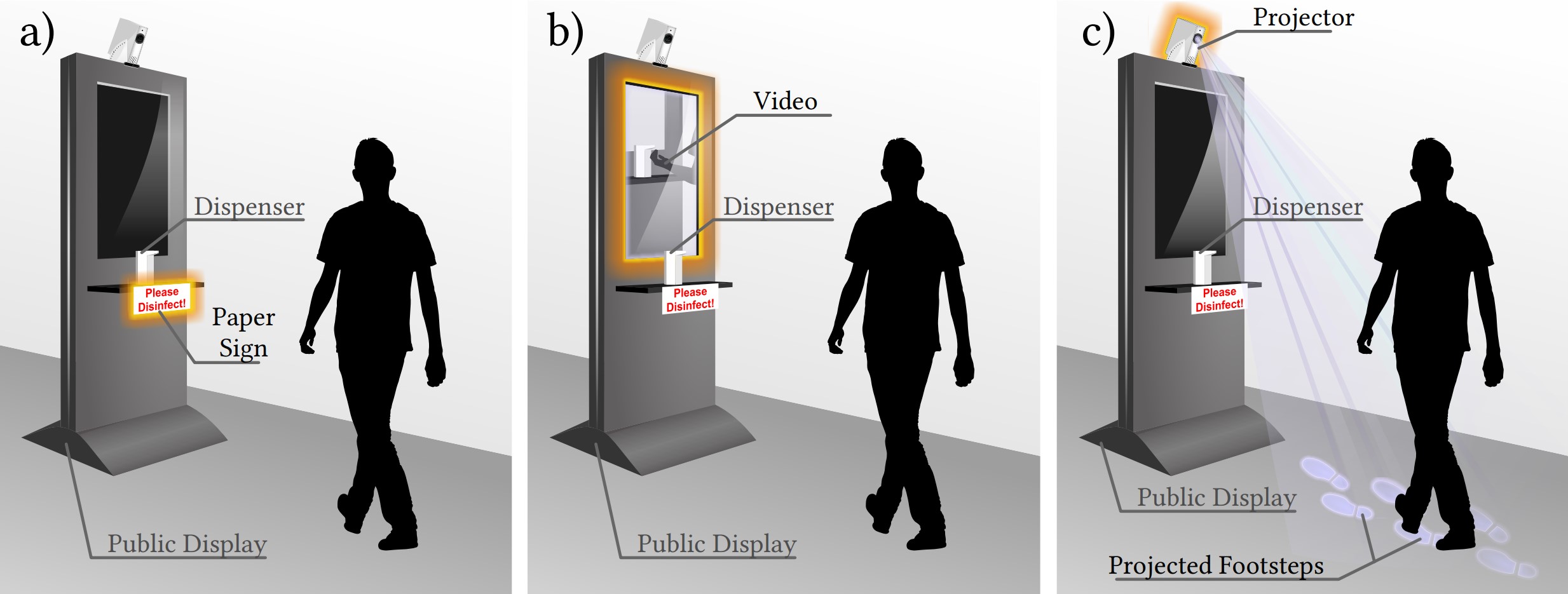Team
Publications:
- Keppel, Jonas; Strauss, Marvin; Faltaous, Sarah; Liebers, Jonathan; Heger, Roman; Gruenefeld, Uwe; Schneegass, Stefan: Don't Forget to Disinfect: Understanding Technology-Supported Hand Disinfection Stations. In: Proc. ACM Hum.-Comput. Interact., Vol 7 (2023). doi:10.1145/3604251PDFCitationAbstractDetails
The global COVID-19 pandemic created a constant need for hand disinfection. While it is still essential, disinfection use is declining with the decrease in perceived personal risk (e.g., as a result of vaccination). Thus this work explores using different visual cues to act as reminders for hand disinfection. We investigated different public display designs using (1) paper-based only, adding (2) screen-based, or (3) projection-based visual cues. To gain insights into these designs, we conducted semi-structured interviews with passersby (N=30). Our results show that the screen- and projection-based conditions were perceived as more engaging. Furthermore, we conclude that the disinfection process consists of four steps that can be supported: drawing attention to the disinfection station, supporting the (subconscious) understanding of the interaction, motivating hand disinfection, and performing the action itself. We conclude with design implications for technology-supported disinfection.
- Auda, Jonas; Heger, Roman; Gruenefeld, Uwe; Schneegaß, Stefan: VRSketch: Investigating 2D Sketching in Virtual Reality with Different Levels of Hand and Pen Transparency. In: 18th International Conference on Human–Computer Interaction (INTERACT). Springer, Bari, Italy 2021, p. 195-211. doi:10.1007/978-3-030-85607-6_14CitationAbstractDetails
Sketching is a vital step in design processes. While analog sketching on pen and paper is the defacto standard, Virtual Reality (VR) seems promising for improving the sketching experience. It provides myriads of new opportunities to express creative ideas. In contrast to reality, possible drawbacks of pen and paper drawing can be tackled by altering the virtual environment. In this work, we investigate how hand and pen transparency impacts users’ 2D sketching abilities. We conducted a lab study (N=20N=20) investigating different combinations of hand and pen transparency. Our results show that a more transparent pen helps one sketch more quickly, while a transparent hand slows down. Further, we found that transparency improves sketching accuracy while drawing in the direction that is occupied by the user’s hand.
- Schneegaß, Stefan; Auda, Jonas; Heger, Roman; Grünefeld, Uwe; Kosch, Thomas: EasyEG: A 3D-printable Brain-Computer Interface. In: Proceedings of the 33rd ACM Symposium on User Interface Software and Technology (UIST). Minnesota, USA 2020. doi:https://doi.org/10.1145/3379350.3416189CitationAbstractDetails
Brain-Computer Interfaces (BCIs) are progressively adopted by the consumer market, making them available for a variety of use-cases. However, off-the-shelf BCIs are limited in their adjustments towards individual head shapes, evaluation of scalp-electrode contact, and extension through additional sensors. This work presents EasyEG, a BCI headset that is adaptable to individual head shapes and offers adjustable electrode-scalp contact to improve measuring quality. EasyEG consists of 3D-printed and low-cost components that can be extended by additional sensing hardware, hence expanding the application domain of current BCIs. We conclude with use-cases that demonstrate the potentials of our EasyEG headset.


